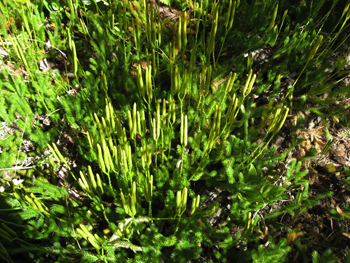Contents:
Common Names | Parts Usually Used | Plant(s) & Culture | Where Found | Medicinal Properties
Legends, Myths and Stories | Uses | How Sold | Warning | Bibliography
Scientific Names

- Lycopodium clavatum L.
- Clubmoss family
Common Names
- Common clubmoss
- Foxtail
- Ground pine
- Lycopod
- Running clubmoss
- Staghorn
- Vegetable sulfur
- Wolf claw
Parts Usually Used
Spores
Back to Top

Description of Plant(s) and Culture
Club moss is a low perennial plant; a moss-like evergreen, 3-15 inches high with creeping runners; the creeping, slender stem roots all along its length and sends up branches bearing tiny, stiff, linear, green leaves tipped with a white, soft, hairlike bristle. The yellow spores, with 1-6 strobiles, are borne on 1 or 2 club-like spikes growing on a long footstalk from the end of a branch.
Back to Top
Where Found
Found in dry, coniferous forests and acid soils all over the world. In North America; Canada south to New York, North Carolina mountains; west to Wisconsin, Washington.
Back to Top
Medicinal Properties
Hemostatic, vulnerary
Back to Top
Legends, Myths and Stories
A related Chinese species in the clubmoss family is being researched as a potential treatment for Alzheimer’s disease.
Back to Top
Uses
Native Americans, as well as Europeans, have used club moss spores as a powder to stop nosebleed, post-partum pains, fever, diarrhea, dysentery, gastric sedative, aphrodisiac, styptic, rheumatism, diaper rash, tangled or matted hair with vermin, herpes, eczema, dermatitis in folds of skin, erysipelas, and bleeding from wounds. The powder has been used to absorb fluids from damaged tissues in various injuries. At one time, it coated pills to prevent the pills from sticking together when packed. Native Americans also used to sprinkle the powder made from this herb on wounds to stop bleeding.
Back to Top
How Sold
Powder or extract of this herb is sold in health food stores and herb shops.
Back to Top
Warning
The plant itself is poisonous, but the spores are not poisonous.
This clubmoss (L. clavatum) contains a toxic alkaloid.
Back to Top
Bibliography
![]() American Folk Medicine
American Folk Medicine, by Clarence Meyer, Meyerbooks, publisher, PO Box 427, Glenwood, Illinois 60425, 1973
![]() Eastern/Central Medicinal Plants
Eastern/Central Medicinal Plants, by Steven Foster and James A. Duke., Houghton Mifflin Company, 215 Park Avenue South, New York, NY 10000
![]() The Herb Book
The Herb Book, by John Lust, Bantam Books, 666 Fifth Avenue, New York, NY. copyright 1974.
 Earl Mindell’s Herb Bible
Earl Mindell’s Herb Bible, by Earl Mindell, R.Ph., Ph.D., Simon & Schuster/Fireside, Rockefeller Center 1230 Avenue of the Americas, New York, New York 10020
 How Indians Use Wild Plants for Food, Medicine & Crafts
How Indians Use Wild Plants for Food, Medicine & Crafts, by Frances Densmore, Dover Publications, Inc., 180 Varick Street, New York, NY 10014, first printed by the United States Government Printing Office, Washington, in 1928, this Dover edition 1974
![]() The Nature Doctor: A Manual of Traditional and Complementary Medicine
The Nature Doctor: A Manual of Traditional and Complementary Medicine, by Dr. H.C.A. Vogel; Keats Publishing, Inc., 27 Pine Street (Box 876) New Canaan, CT. 06840-0876. Copyright Verlag A. Vogel, Teufen (AR) Switzerland 1952, 1991
![]() Webster’s New World Dictionary
Webster’s New World Dictionary, Third College Edition, Victoria Neufeldt, Editor in Chief, New World Dictionaries: A Division of Simon & Schuster, Inc., 15 Columbus Circle, New York, NY 10023
 The Rodale Herb Book: How to Use, Grow, and Buy Nature’s Miracle Plants (An Organic gardening and farming book)
The Rodale Herb Book: How to Use, Grow, and Buy Nature’s Miracle Plants (An Organic gardening and farming book), edited by William H. Hylton, Rodale Press, Inc. Emmaus, PA, 18049., 1974
